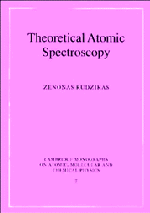Book contents
- Frontmatter
- Contents
- Preface
- Foreword to the Paperback Edition
- Introduction
- Part 1 Energy Spectrum of Many-electron Atom. Radiative and Autoionizing Transitions (Initial Formulas)
- Part 2 Foundations of the Angular Momentum Theory. Graphical Methods
- 5 Angular momentum and tensorial algebra
- 6 Main quantities of angular momentum theory
- 7 Angular momentum theory for relativistic case
- 8 Graphical methods: their generalization for perturbation theory
- Part 3 Description of Complex Electronic Configurations
- Part 4 Second-quantization in the Theory of an Atom. Quasispin and Isospin
- Part 5 Matrix Elements of the Energy Operator
- Part 6 Electric and Magnetic Multipole Transitions
- Part 7 Calculation of Energy Spectra and Electronic Transitions in the Case of Complex Configurations
- Epilogue
- References
- Index
7 - Angular momentum theory for relativistic case
Published online by Cambridge University Press: 21 September 2009
- Frontmatter
- Contents
- Preface
- Foreword to the Paperback Edition
- Introduction
- Part 1 Energy Spectrum of Many-electron Atom. Radiative and Autoionizing Transitions (Initial Formulas)
- Part 2 Foundations of the Angular Momentum Theory. Graphical Methods
- 5 Angular momentum and tensorial algebra
- 6 Main quantities of angular momentum theory
- 7 Angular momentum theory for relativistic case
- 8 Graphical methods: their generalization for perturbation theory
- Part 3 Description of Complex Electronic Configurations
- Part 4 Second-quantization in the Theory of an Atom. Quasispin and Isospin
- Part 5 Matrix Elements of the Energy Operator
- Part 6 Electric and Magnetic Multipole Transitions
- Part 7 Calculation of Energy Spectra and Electronic Transitions in the Case of Complex Configurations
- Epilogue
- References
- Index
Summary
Angular momentum
The main ideas of angular momentum theory (e.g. central field approximation, self-consistent field method, etc.) are fairly general and are equally applicable for both the non-relativistic and relativistic theories of many-electron atoms and ions in spite of the fact that the corresponding energy operators differ significantly in nature. This distinction manifests itself in different kinds of wave functions (non-relativistic (1.14) and relativistic (2.15) or (2.18)). Strong interaction of orbital L and spin s momenta of an electron in relativistic approximation leads, as we shall see in Chapter 9, to the splitting of a shell of equivalent electrons into subshells according to j = L + s values and to the occurrence of jj coupling inside these subshells and between them. In order to use the mathematical apparatus of the angular momentum theory, we have to write all the operators in j-representation, i.e. express them in terms of the quantities which transform like the eigenfunctions of the operators j2 and jz. From a mathematical point of view the main difference between non-relativistic and relativistic momenta is that in a non-relativistic case we have one-electron angular and spin momenta, which can acquire integer and half-integer numerical values, correspondingly, whereas in a relativistic case we have only one-electron total momentum, acquiring half-integer numerical values. However, they all satisfy the same commutation conditions (5.2), and all formulas of Chapter 5 on tensorial algebra are equally applicable in both cases.
- Type
- Chapter
- Information
- Theoretical Atomic Spectroscopy , pp. 57 - 62Publisher: Cambridge University PressPrint publication year: 1997

